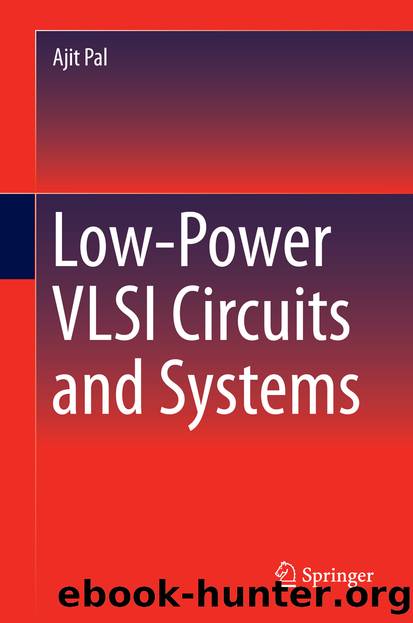Low-Power VLSI Circuits and Systems by Ajit Pal

Author:Ajit Pal
Language: eng
Format: epub
Publisher: Springer India, New Delhi
Fig. 7.18Signal going from low-V dd to high-V dd domain causing a short-circuit current
High-to-Low-Voltage Level Converters
The need for a level converter as a signal passes from high-V dd domain to low-V dd domain arises primarily to provide a clean signal having a desired voltage swing and rise and fall times. Without a level converter, the voltage swing of the signal reaching the low-V dd domain is 0 to V ddH. This causes higher switching power dissipation and high leakage power dissipation due to GIDL effect. Moreover, because of the longer wire length between the voltage domains, the rise and fall time may be long leading to increase in short-circuit power dissipation. To overcome this problem, a level converter as shown in Fig. 7.19b may be inserted. The high-to-low level converter is essentially two inverter stages in cascade. It introduces a buffer delay and its impact on the static timing analysis is small.
Download
This site does not store any files on its server. We only index and link to content provided by other sites. Please contact the content providers to delete copyright contents if any and email us, we'll remove relevant links or contents immediately.
Algorithms of the Intelligent Web by Haralambos Marmanis;Dmitry Babenko(8310)
Test-Driven Development with Java by Alan Mellor(6807)
Data Augmentation with Python by Duc Haba(6722)
Principles of Data Fabric by Sonia Mezzetta(6469)
Learn Blender Simulations the Right Way by Stephen Pearson(6375)
Microservices with Spring Boot 3 and Spring Cloud by Magnus Larsson(6241)
Hadoop in Practice by Alex Holmes(5966)
Jquery UI in Action : Master the concepts Of Jquery UI: A Step By Step Approach by ANMOL GOYAL(5816)
RPA Solution Architect's Handbook by Sachin Sahgal(5642)
Big Data Analysis with Python by Ivan Marin(5402)
The Infinite Retina by Robert Scoble Irena Cronin(5331)
Life 3.0: Being Human in the Age of Artificial Intelligence by Tegmark Max(5160)
Pretrain Vision and Large Language Models in Python by Emily Webber(4367)
Infrastructure as Code for Beginners by Russ McKendrick(4136)
Functional Programming in JavaScript by Mantyla Dan(4044)
The Age of Surveillance Capitalism by Shoshana Zuboff(3964)
WordPress Plugin Development Cookbook by Yannick Lefebvre(3847)
Embracing Microservices Design by Ovais Mehboob Ahmed Khan Nabil Siddiqui and Timothy Oleson(3651)
Applied Machine Learning for Healthcare and Life Sciences Using AWS by Ujjwal Ratan(3628)
